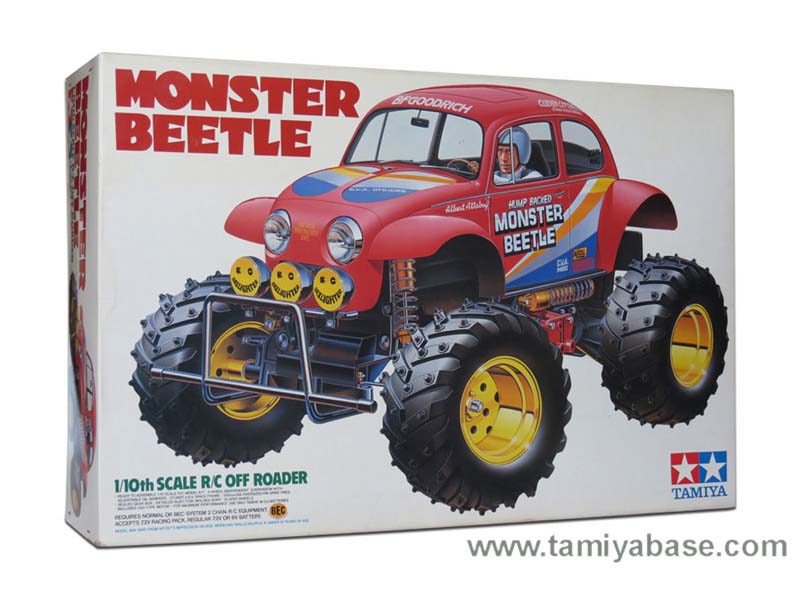And combining their high-rise, go anywhere looks with the evergreen shape of a VW Beetle resulted in yet another hit for the Japanese model company Tamiya.
With the advent in 1985/1986 of such big-wheeled off road truck kits as the Marui Big Bear and the Tamiya Blackfoot, monster trucks had truly arrived in the R/C toy world. Full size stadium Monster Truck events were of course popular in the US, and like all popular full-scale motor sports, the action was bound to end up recreated in toy form sooner or later.
By 1986 Tamiya was firmly entrenched as the world’s most popular hobby-grade R/C brand thanks largely to it’s colourful buggy models. And despite rival Japanese model kit company Marui being quicker to release a 1/10 scale monster truck with it’s “Big Bear” kit, Tamiya soon followed with the Blackfoot and then the Monster Beetle.
The Monster Beetle was first released on the 23rd of December, 1986… some 27 years ago, as I write this.
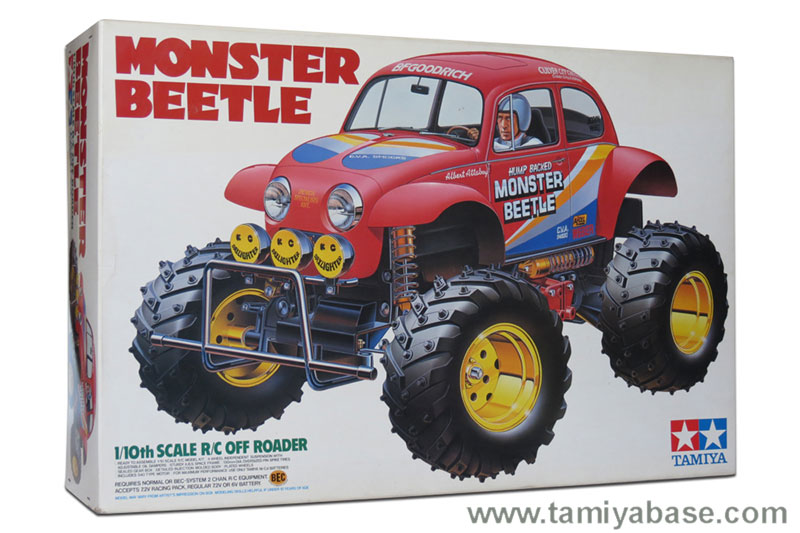
It’s funny to think that none of these kit based monster vehicles were 4WD though – as you’d expect monster trucks to be (and, as I assume, most of the real ones were). The complexity and cost of 4×4 transmissions in a model kit were apparently not good economics, in 1986, for the price-point at which these vehicles were aimed.
Tamiya had already released some far more expensive, scale truck models with full 4WD gearing (and even shiftable transmissions), but it seems they wanted to keep their first big-footed vehicles as 2WDs. And they were none-the-less still highly entertaining to both build and drive.
You’ve probably noticed by now that I’m quite a VW fan when it comes to toys. And while I’m more into off-road buggies than anything else, the Monster Beetle was a model I came across many years ago in lucky circumstances. And I developed a great appreciation for this model.
The Monster Beetle is of course another 1/10 scale, kit-based, hobby-grade R/C legend from the golden era of Tamiya R/C models in the mid 1980s.
Growing up back then, I had no chance of owning it. But by 1994 I was in my teens, and already something of an avid hunter/collector of vintage R/C items. One day in 1994 I had decided to ring around a few hobby stores, out of the blue, just to see if they still had any old kits from the 1980s left in stock. Looking back now, it was a very real possibility that I might find some classic models – but despite this I only managed to find one store that had anything interesting – they had one Monster Beetle left.
On my limited budget, I saved up for several weeks to pay it off – and finally purchased what might have been the very last “retail stock” Monster Beetle kit left in Australia.
This is it today…
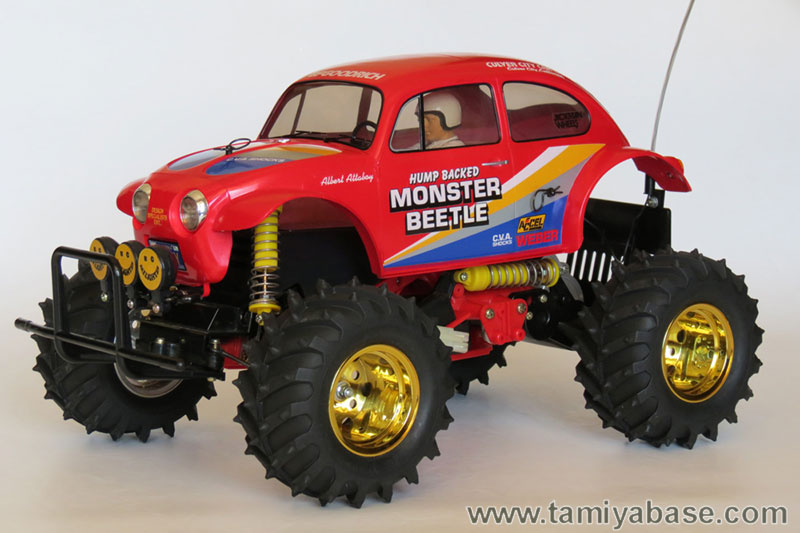
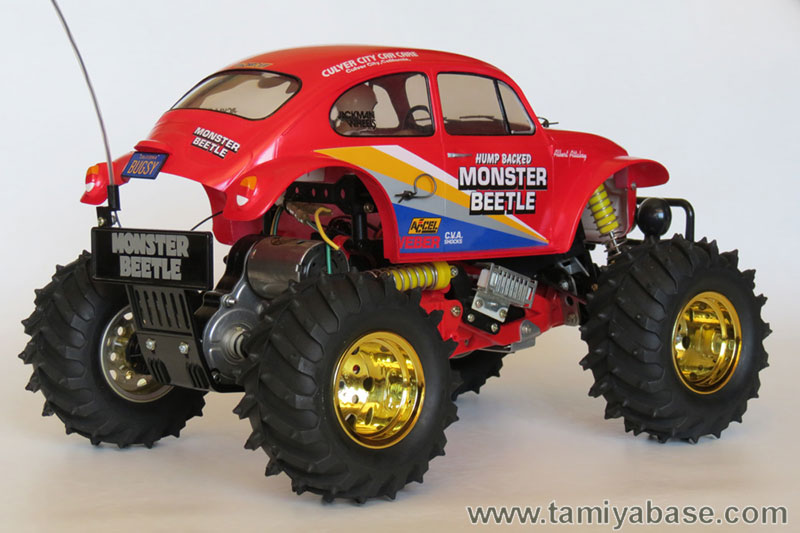
I actually built part of this model in 1994. And the rest of it many years later, eventually completing all the small details. The joy of building a model like the Monster Beetle is that if you make the effort to do everything, there’s a fair amount of small detail that ends up being really satisfying to complete.
Before I continue any further, let’s talk aboutk at the original Monster Beetle video promo clip…
These old videos often used to appear on TV sets in Hobby Shops, as in-store promotion to help tempt customers.
Elsewhere, the legendary Tamiya catalogues – for me, their best marketing – featured the Monster Beetle in the 1987 annual issue…
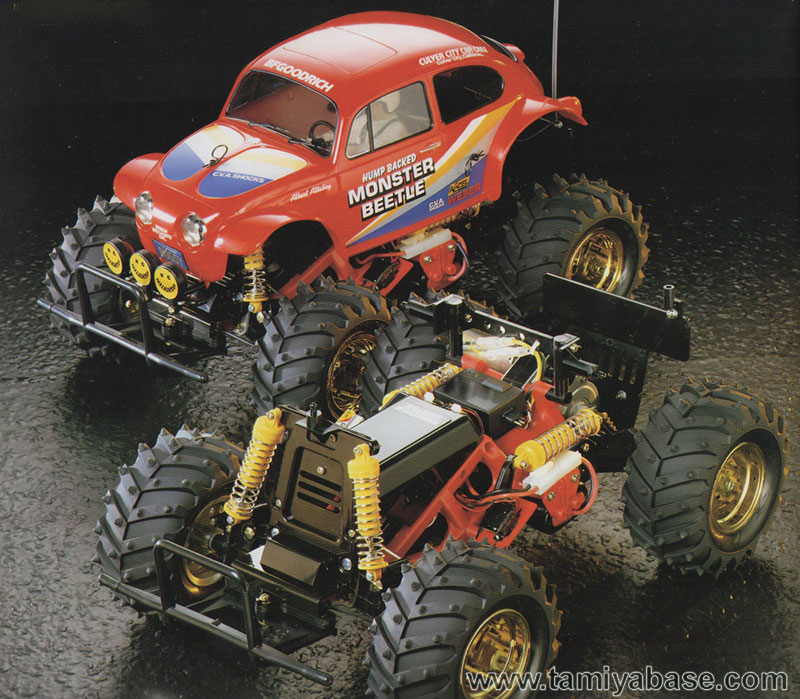
Also seen in the catalogues were these two images…
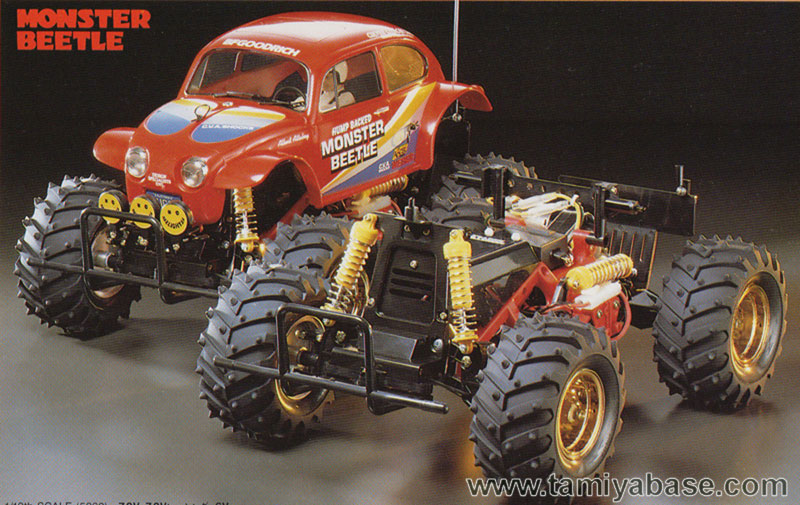
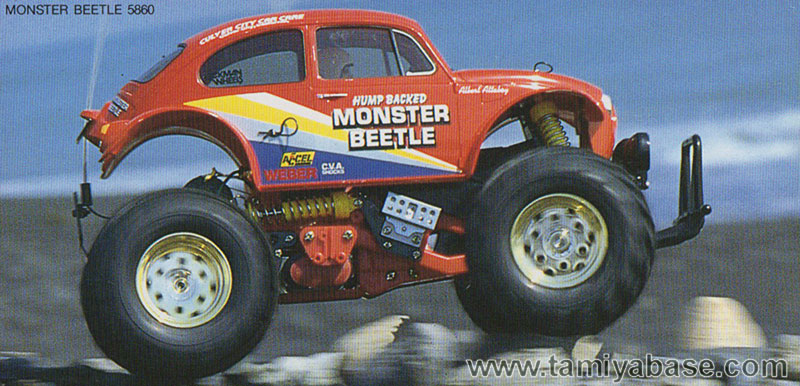
I tried to carefully recreate this exact look, when building this model. So I hope it looks pretty close.
The Monster Beetle is actually based on an earlier chassis that Tamiya had created – initially for the Subaru Brat, but it is equally known as the chassis of the Tamiya Frog. It’s an unusual chassis for it’s time – referred to as a “space frame” because it consists of two lightweight plastic halves that are screwed together and have a lot of holes in them to save weight, while still remaining rigid.
Tamiya has always had a tendency to adapt it’s models into other models, in an effort to conjure something new at the same time as saving on tooling (molds were very expensive items back in those days!). So the Monster Beetle is also an adaptation of the Tamiya Sand Scorcher, their original VW off-roader from 1979, in the sense that the highly detail hard plastic body of that earlier car has been re-used and adjusted slightly, for this release.
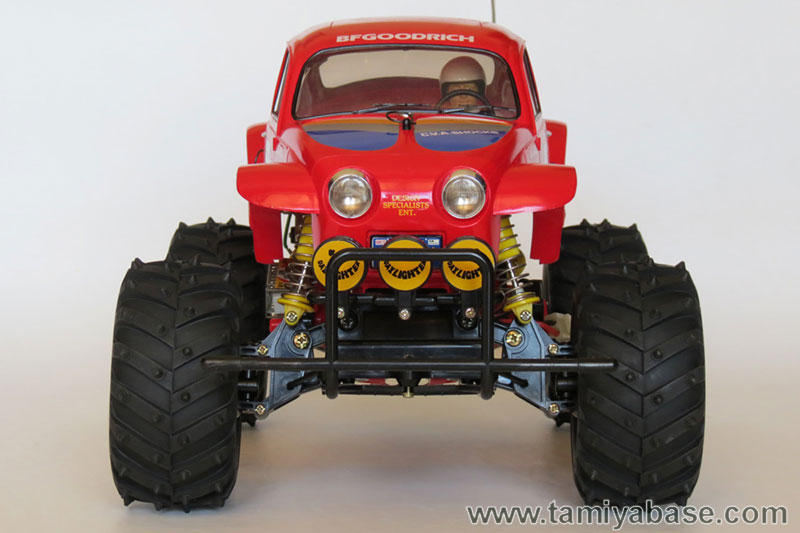
Despite looking like a 4WD (yet being 2WD) as I mentioned earlier, one area in which the Monster Beetle didn’t cut corners was suspension – it is fully independent, both front and rear, and features Tamiya’s yellow “CVA” (Constant Volume Adjustable) shock absorbers, which you fill with oil to provide sophisticated damping. The earlier “Blackfoot” monster truck didn’t have these oil-filled units, so in that sense the Monster Beetle was a step-up from that model and a bit more capable.
Having said that, I’ve always found that if you leave a Monster Beetle on the shelf for a long time, and then run it, you may need to “wake up” those shocks and get them pumping again (depress them a few times) as they do have a tendency to stick a little bit due to lack of play, and the suspension movement on this car is a little “tight” compared to some other hobby grade models.
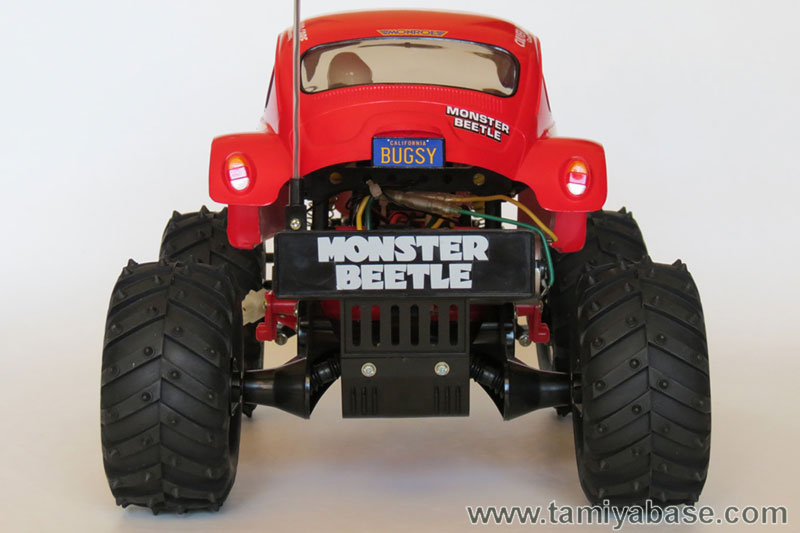
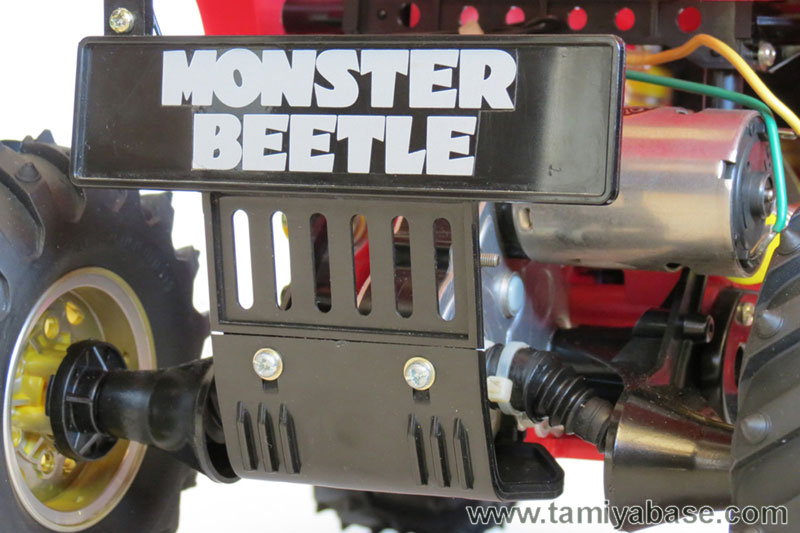
In the photos above, you can see the large, silver Mabuchi 540 motor – standard in most Tamiya kit models, yet still to this day a powerful engine that really marks the difference between most of the toy-grade R/C cars (like many of those featured on this site) and the hobby-grade ones. Any car with at least a 540 motor, is likely to have a top speed of over 20km/h.
Also visible above are the rubber boots that house the rear drive shafts. With hard running, this system is a bit of a weakness of this model (and others in the Tamiya range that use it) as the driveshafts have hexagonal ends that can eventually wear down. It’s also funny to think that the rubber boots were held on by plastic ties! But this was the official way to build the kit. And if you don’t run your cars *too* hard, and keep the stressed components like these well lubricated with Molybdenum grease, then they will operate well for many years.
This car is also equipped with enough space inside the chassis for the 4 x AA cells that most early hobby-grade R/C cars used to require, to power their radio receiver units – something I usually opt for whenever I build vintage cars, because it means the car always has battery power for steering (and therefore there’s no risk of losing control of it once the 7.2v pack has run out).
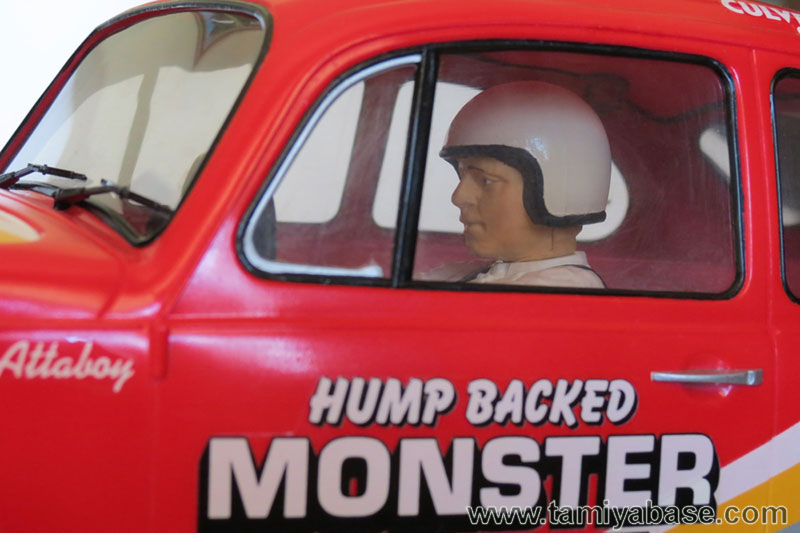
The car is covered in humourous and real brands and logo.
I had a lot of fun painting and detailing this model, including the window frames and the driver figure inside. It wasn’t really that hard – just time consuming. The key is to be patient and take your time. It may take quite a few days as you let the paint dry, and do a bit more each time.
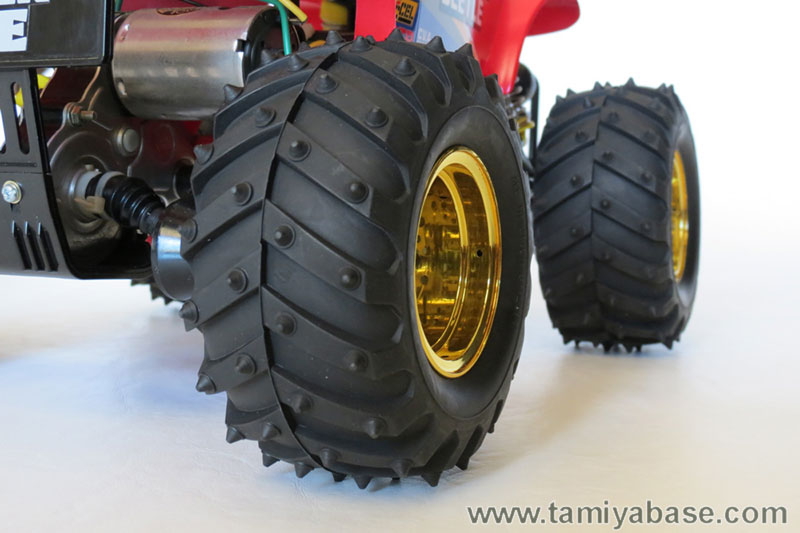
Aside from all the obviously excellent body details, right down to the silver VW badge on the bonnet, one of the most noticeable features of the Monster Beetle are it’s gold wheels and the introduction of the large, pin spike tyres that it uses. It was the first Tamiya model to use these particular tyres and wheels. They’re quite tall and soft, which means they are quite flabby under hard cornering and a bit bouncy as well. But this is part of the joy of old 1980s R/C cars – big, soft tyres that look great and work best when digging through sand dunes.
After all, who cares about racing performance – the Monster Beetle was designed for bouncy, big wheeled fun!
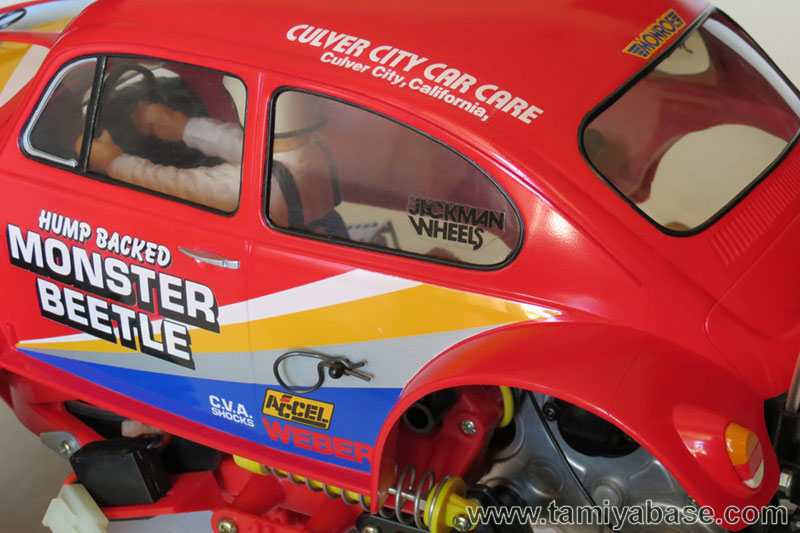
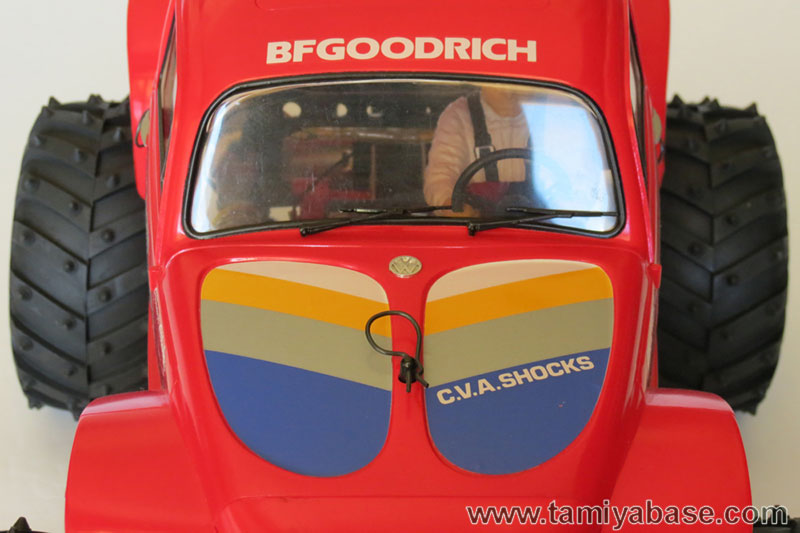
Driving the Monster Beetle is pretty easy. Despite being fast, like any 540 motor powered model, the car is quite wide and stable. So on dirt at least, it never really feels like it’s going to topple over. It’s not as fast as the more racing oriented R/C trucks from the late 1980s, but it’s still pretty entertaining in my experience. It’s very much a fun vehicle that looks amazing with it’s highly detailed body.
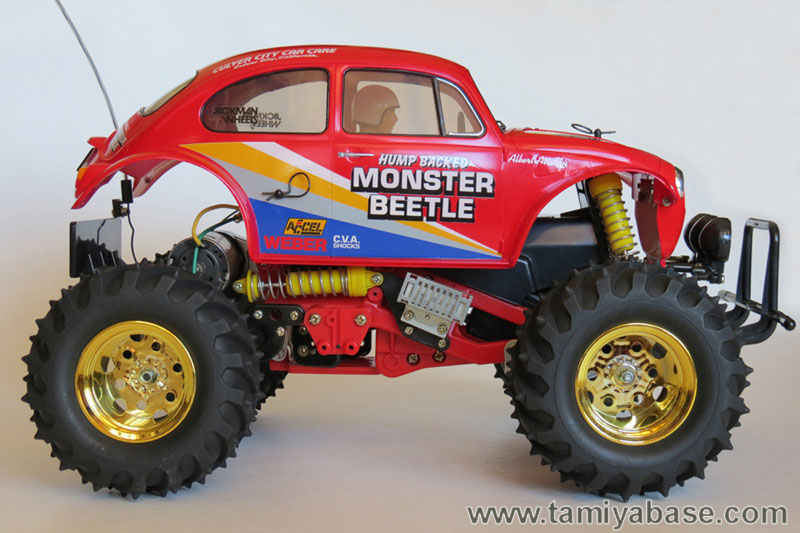
I’m slightly surprised Tamiya didn’t give it a more colourful name like their other cars of that era, but I guess “Monster Beetle” is a pretty straightforward and literal way to sum it up!
At the time of writing, the Monster Beetle is one of the few remaining Tamiya models of the 1980s that has not been rehashed by the company, to cash in on nostalgia. Although I’m sure that can’t be too far away, because… “money”.
Nevertheless, no rehash will be quite the same as the original 1986 release, with all it’s pure California summertime logos, and 1980s technology!
Currently, like all vintage Tamiyas, the Monster Beetle is quite collectible and sought-after. Used examples will generally sell for more than $100, and the cost increases depending on condition. A still unbuilt original kit is likely to fetch somewhere over $600 (although I’ve seen prices fluctuate quite a bit over the years, so this is just a rough guide).
But if you like off-road Volkswagen Beetles as much as me, or if you’re a fan of monster trucks, the Monster Beetle is a quintessential R/C model that you simply must have in your collection.
| At a glance… |
| Scale: 1/10 |
| Length: 42cm |
| Drive: 2WD |
| Motor: RS-540S |
| Gearbox: 1-Speed |
| Differential: Yes |
| Suspension: Yes |
| Digital Proportional: Yes |
| Batteries: 1 x 7.2volt, optional 4 x AA (Car). Transmitter purchased separately. |
| Original price in Australia back in 1986: AU$250 |
| What this would equate to, in 2012 money: AU$590 (calculated using this) |
| Top Speed (measured so far): TBA |
________________________
Article written by TB member Hibernaculum and originally published at www.rctoymemories.com

